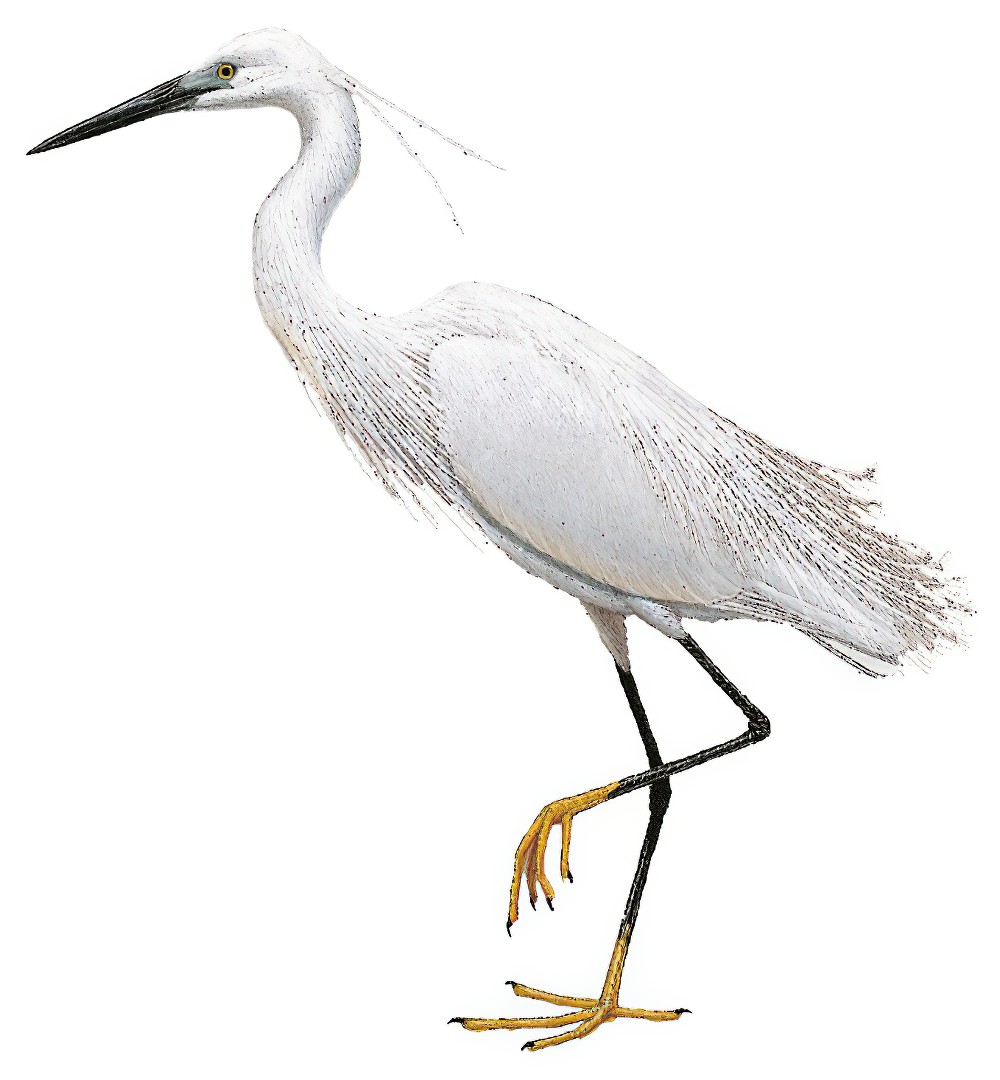Little Egret / Egretta garzetta

Little Egret
SCI Name:
Protonym: Ardea Garzetta Syst.Nat.ed.12 ed.12 p.237
Taxonomy: Pelecaniformes / Ardeidae / Egretta
Taxonomy Code: litegr
Type Locality: 'Oriente,'' ex Brisson.
Author: Linnaeus
Publish Year: 1766
IUCN Status:
DEFINITIONS
EGRETTA
(Ardeidae; † Little Egret E. garzetta) French Aigrette egret < dim. Provençal Aigron heron; "EGRETTA GARZETTA? The Egret?" (T. Forster 1817); "Egretta T. Forster, Synopt. Cat. Brit. Bds., 1817, p. 59. Type, by monotypy, Ardea garzetta Linné." (Peters, 1931, I, p. 110).
Var. Egetta.
Synon. Demigretta, Dichromanassa, Erodius, Florida, Garzetta, Glaucerodius, Hemiegretta, Hemigarzetta, Herodias, Hydranassa, Lepterodas, Leucophoyx, Melanophoyx, Notophoyx.
egretta
French Aigrette egret < dim. Provençal Aigron heron.
● ex “Guiratinga” of Ray 1713, “Grande Aigrette d’Amérique” of d’Aubenton, 1765-1781, pl. 925, “Grande Aigrette” of de Buffon 1770-1786, and “Great Egret” of Pennant 1785, and Latham 1785 (subsp. Ardea alba).
garzetta
Italian names Garzetta or Sgarzetta for the Little Egret; ex “Aigrette” of Brisson 1760 (Egretta).
Garzetta
(Ardeidae; syn. Egretta † Little Egret E. garzetta) Specific name Ardea garzetta Linnaeus, 1766; "5. Ardea garzetta, egretta. ... 5. Garzette. Garzetta. E[ntwickelung]. Der Schnabel wird länger und verliert auch jede Spur von Zähnen; die Zehen verlängern sich, ebenso die Nägel wovon der der Mittelzehe an seinem innern Rand gezähnelt wird; die Spannhaut der inneren Zehe hat sich gänzlich in den Winkel der inneren und mittleren Zehe zurückgezogen. Das blendend weiße Gefieder des Schwans wiederholt sich. Ch[arakter]. Reiher mit silberweißem Gefieder. L[ebensart]. Sie leben im Süden beider Welten, nähren sich von Fischen und nisten im Schilf oder auf Bäumen. Ihre Eier sind einfarbig und ihre Jungen, wie die Störche, Nesthocker." (Kaup 1829); "Garzet Heron - Ardea garzetta, Linn. - Héron garzette, Fr. - Sgarza garzetta, It. - Straues Rieher, G. ... In Egypt it is called the "Oxkeeper," from its associating with the cattle, and feeding on the larvæ with which the backs of these animals are infested [this refers to the Cattle Egret Bubulcus, whose Arabic name is Abu Qurdaan father of ticks]. .... We beg to suggest the propriety of removing this bird from the genus Ardea. It might stand as the Garzetta pusilla" (C. T. Wood 1837); "112. Garzetta, Bp. ex Kaup. 1829. (Herodias part. Gr. - Egretta, part. Hartl) Rostrum longulum, gracilimum, minus conmpressum, HERODIACEUM, nigrum: pedes longi; tibiae valde denudatae. Minores. Candidae, unicolores in omni tempore et aetate: tergi plumae elongatae, quadriseriales. Cosmop. 6. 1. ARDEA GARZETTA, L. (egretta, Br. - nivea, S. G. Gm. nec Lath. quae G. candissima. - xanthodactyla, Gm. juv. ... 2. ARDEA orientalis, J. Gr. ... 3. ARDEA nigripes, Temm. excl. Man. Orn. IV. p. 377. quae Egretta melanopus. (Herodias garzetta, var. Blyth. ... 4. HERODIAS immaculata, Gould. (H. garzetta junior Novae-Hollandiae, Blyth. ... 5. ARDEA candidissima, Gm. (nivea, Lath. nec Gm. quae Garzetta egretta. - alba minor, Bartr. - carolinensis, Ord. - aequinoctialis? Gm. part. nec L. - Herodias candissima, Gr. - Egretta nivea, Caban. nec Auct. ... 6? ARDEA ohula, Gm. ex Molina. (lactea? Less. ex Cayenna.)" (Bonaparte 1855); "Garzetta Kaup, Skizz. Entwick.-Gesch. Nat. Syst. p. 76 (pref. April 1829). Type (by tautonymy): A. garzetta Linné." (Mathews, 1927, Syst. Av. Austral., I, p. 194).
SUBSPECIES
Little Egret (Western)
SCI Name: Egretta garzetta garzetta
garzetta
Italian names Garzetta or Sgarzetta for the Little Egret; ex “Aigrette” of Brisson 1760 (Egretta).
Little Egret (Australasian)
SCI Name: Egretta garzetta nigripes
nigripes
L. niger black; pes, pedis foot < Gr. πους pous, ποδος podos foot.
Little Egret (Dimorphic)
SCI Name: Egretta garzetta dimorpha
dimorpha / dimorphicus
Gr. διμορφος dimorphos dimorphic, of two forms < δι- di- double < δις dis twice < δυο duo two; μορφη morphē form.
● “Il nome specifico dimorpha allude appunto al diverso disegno delle parti superiori e delle inferiori; queste come quelle dell’ O. brachyotus [= Asio flammeus] e le superiori come quelle delle due specie [Ninox rufa humeralis, Ninox rufa aruensis] descritte dello Schlegel” (Salvadori 1874) (Uroglaux).
UPPERCASE: current genus
Uppercase first letter: generic synonym
● and ● See: generic homonyms
lowercase: species and subspecies
●: early names, variants, mispellings
‡: extinct
†: type species
Gr.: ancient Greek
L.: Latin
<: derived from
syn: synonym of
/: separates historical and modern geographic names
ex: based on
TL: type locality
OD: original diagnosis (genus) or original description (species)












